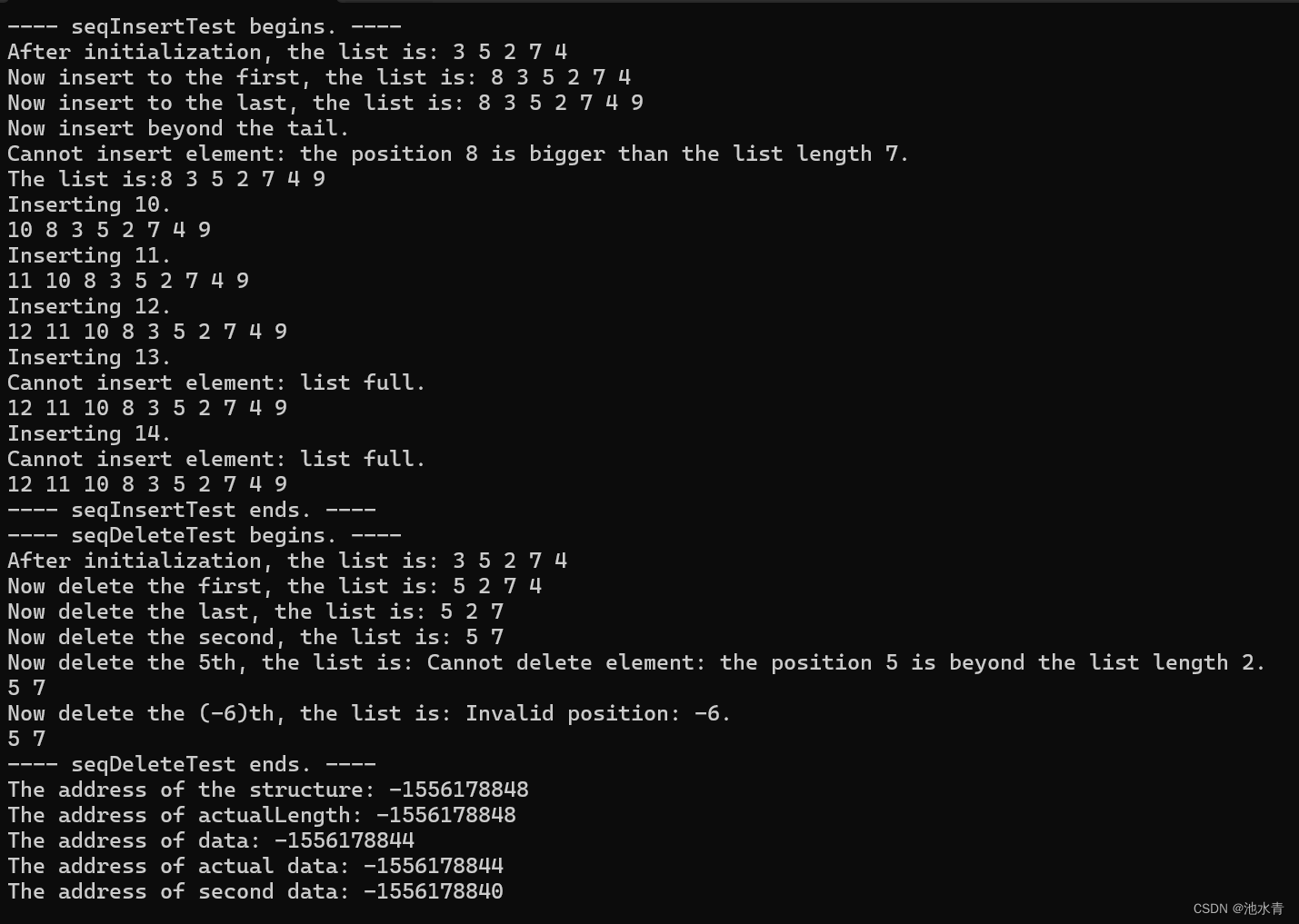#include <stdio.h> #include <malloc.h> #define LIST_MAX_LENGTH 10 //定义一个结构体,包含当前长度,一个数组 typedef struct SeqList { int actualLength; int data[LIST_MAX_LENGTH]; //The maximum length is fixed. } *SeqListPtr; //输出结构体内数组 void outputList(SeqListPtr paraList) { for(int i = 0; i < paraList->actualLength; i ++) { printf("%d ", paraList->data[i]); }// Of for i printf("\r\n"); }// Of outputList /** * 输出结构体所有地址 */ void outputMemory(SeqListPtr paraListPtr) { printf("The address of the structure: %ld\r\n", paraListPtr); printf("The address of actualLength: %ld\r\n", ¶ListPtr->actualLength); printf("The address of data: %ld\r\n", ¶ListPtr->data); printf("The address of actual data: %ld\r\n", ¶ListPtr->data[0]); printf("The address of second data: %ld\r\n", ¶ListPtr->data[1]); }// Of outputMemory /* * 开辟一个该结构体类型的空间,并填充 */ SeqListPtr seqListInit(int paraData[], int paraLength) { SeqListPtr resultPtr =(SeqListPtr)malloc(sizeof(struct SeqList)); for (int i = 0; i < paraLength; i++) { resultPtr->data[i] = paraData[i]; }// Of for i resultPtr->actualLength = paraLength; return resultPtr; } /** * 向该结构体内数组插入数据 */ void seqListInsert(SeqListPtr paraListPtr, int paraPosition, int paraValue) { // Step 1. Space check. if (paraListPtr->actualLength >= LIST_MAX_LENGTH) { printf("Cannot insert element: list full.\r\n"); return; }//Of if // Step 2. Position check. if (paraPosition < 0) { printf("Cannot insert element: negative position unsupported."); return; }//Of if if (paraPosition > paraListPtr->actualLength) { printf("Cannot insert element: the position %d is bigger than the list length %d.\r\n", paraPosition, paraListPtr->actualLength); return; }//Of if // Step 3. Move the remaining part. for (int i = paraListPtr->actualLength; i > paraPosition; i --) { paraListPtr->data[i] = paraListPtr->data[i - 1]; }//Of for i // Step 4. Insert. paraListPtr->data[paraPosition] = paraValue; // Step 5. Update the length. paraListPtr->actualLength ++; }// Of sequentialListInsert /** * 测试插入 */ void seqInsertTest() { int i; int tempArray[5] = {3, 5, 2, 7, 4}; printf("---- seqInsertTest begins. ----\r\n"); // Initialize. SeqListPtr tempList = seqListInit(tempArray, 5); printf("After initialization, the list is: "); outputList(tempList); // Insert to the first. printf("Now insert to the first, the list is: "); seqListInsert(tempList, 0, 8); outputList(tempList); // Insert to the last. printf("Now insert to the last, the list is: "); seqListInsert(tempList, 6, 9); outputList(tempList); // Insert beyond the tail. printf("Now insert beyond the tail. \r\n"); seqListInsert(tempList, 8, 9); printf("The list is:"); outputList(tempList); // Insert to position 3. for (i = 0; i < 5; i ++) { printf("Inserting %d.\r\n", (i + 10)); seqListInsert(tempList, 0, (i + 10)); outputList(tempList); }//Of for i printf("---- seqInsertTest ends. ----\r\n"); }// Of seqInsertTest /** * 删除数据 */ int seqListDelete(SeqListPtr paraListPtr, int paraPosition) { // Step 1. Position check. if (paraPosition < 0) { printf("Invalid position: %d.\r\n", paraPosition); return -1; }//Of if if (paraPosition >= paraListPtr->actualLength) { printf("Cannot delete element: the position %d is beyond the list length %d.\r\n", paraPosition, paraListPtr->actualLength); return -1; }//Of if // Step 2. Move the remaining part. int resultValue = paraListPtr->data[paraPosition]; for (int i = paraPosition; i < paraListPtr->actualLength; i ++) { paraListPtr->data[i] = paraListPtr->data[i + 1]; }//Of for i // Step 3. Update the length. paraListPtr->actualLength --; // Step 4. Return the value. return resultValue; }// Of seqListDelete /** * 测试删除 */ void seqDeleteTest() { int tempArray[5] = {3, 5, 2, 7, 4}; printf("---- seqDeleteTest begins. ----\r\n"); // Initialize. SeqListPtr tempList = seqListInit(tempArray, 5); printf("After initialization, the list is: "); outputList(tempList); // Delete the first. printf("Now delete the first, the list is: "); seqListDelete(tempList, 0); outputList(tempList); // Delete to the last. printf("Now delete the last, the list is: "); seqListDelete(tempList, 3); outputList(tempList); // Delete the second. printf("Now delete the second, the list is: "); seqListDelete(tempList, 1); outputList(tempList); // Delete the second. printf("Now delete the 5th, the list is: "); seqListDelete(tempList, 5); outputList(tempList); // Delete the second. printf("Now delete the (-6)th, the list is: "); seqListDelete(tempList, -6); outputList(tempList); printf("---- seqDeleteTest ends. ----\r\n"); outputMemory(tempList); }// Of seqDeleteTest /** * Locate an element in the list. * @param paraListPtr The pointer to the list. * @param paraValue the indicated value. * @return The position of the value, or -1 indicating not exists */ int locateElement(SeqListPtr paraListPtr, int paraValue) { for (int i = 0; i < paraListPtr->actualLength; i ++) { if (paraListPtr->data[i] == paraValue) { return i; }// Of if }//Of for i return -1; }// Of locateElement /** * Get an element in the list. * @param paraListPtr The pointer to the list. * @param paraPosition The given position. * @return The position of the value, or -1 indicating not exists */ int getElement(SeqListPtr paraListPtr, int paraPosition) { // Step 1. Position check. if (paraPosition < 0) { printf("Invalid position: %d.\r\n", paraPosition); return -1; }//Of if if (paraPosition >= paraListPtr->actualLength) { printf("Cannot get element: the position %d is beyond the list length %d.\r\n", paraPosition, paraListPtr->actualLength); return -1; }//Of if return paraListPtr->data[paraPosition]; }// Of locateElement /** * Clear elements in the list. * @param paraListPtr The pointer to the list. * @return The position of the value, or -1 indicating not exists */ void clearList(SeqListPtr paraListPtr) { paraListPtr->actualLength = 0; }// Of clearList /** The entrance. */ void main() { seqInsertTest(); seqDeleteTest(); }// Of main






















 400
400











 被折叠的 条评论
为什么被折叠?
被折叠的 条评论
为什么被折叠?








